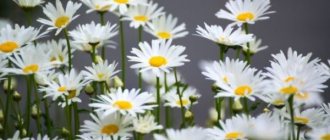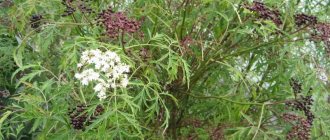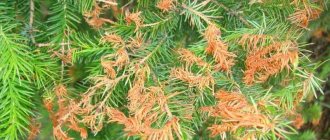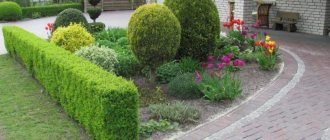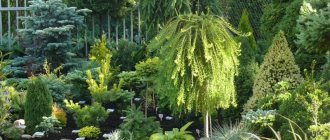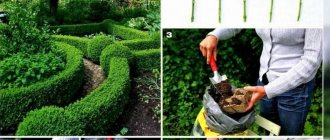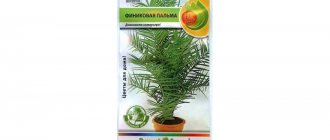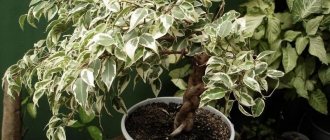Cedar or Siberian pine will decorate and enrich any landscape. Gardeners from the Moscow region and the Black Earth region are faced with the problem of how to plant cedar. With the right agricultural technology, these plants take root well, grow actively and delight you with a harvest of cones. The spreading crown of the Siberian pine will bring shade, phytoncides will purify the air, nuts are healthy and very tasty.
Siberian pine is a winter-hardy plant that can tolerate frosts down to -60 0C; mature cedars are able to withstand urban air pollution. The lifespan of a tree is up to 700 years.
Korean cedar
One of the largest and most impressive representatives of the pine family. Korean cedar can grow up to 45 meters in height, the branches can spread up to 2 meters in length. The tree cones are impressive - up to 15 centimeters. The first nuts can be eaten 2 years after the start of flowering.
The cedar blooms in early June, the cones fall in November, and the nuts are preserved inside.
A distinctive feature of Korean cedar: the nuts contain more healthy fats and microelements and are very nutritious.
In order to enjoy healthy nuts, you will have to wait 40 years, since Korean cedar begins to bear fruit only after reaching 40 years of age and does this regularly every 2 years over the next 400-500 years.
Care
Growing cedar after planting is not particularly difficult. The plant is unpretentious, almost not affected by pests, and does not need to be covered for the winter. Basic care consists of watering and fertilizing.
Important! You cannot loosen the soil under the plant; this will damage the small suction roots of the cedar. The earth is kept under mulch, constantly adding new portions. The mulch layer should be 10–15 cm.
Watering
When planting cedar pine in autumn, one abundant moistening of the soil is sufficient immediately after planting the seedling. When planting a plant in the spring, the soil under the seedlings is moistened regularly, keeping it moderately moist.
As the tree grows older, it is watered less and less - only during periods of severe drought.
On a note. In summer, cedar responds positively to evening irrigation of the crown from a watering can or hose. Water washes away dust from the needles, improving the breathing process and increasing air humidity.
As the tree grows older, it is watered less and less - only during periods of severe drought.
Top dressing
To feed cedar pine, mineral compositions containing microelements are used.
In the spring, after the snow melts, it is allowed to mulch the cedar tree trunk with compost or rotted manure. Spend from 1 to 7 buckets of fertilizer per seedling.
If in the spring it is discovered that the needles on the cedar have turned yellow, the plant is sprayed with a special composition that returns the emerald color to the needles (“Forte”, “Agricola”, “Pokon”).
At the beginning of autumn, phosphorus-potassium compounds with magnesium, boron, and manganese are added to the soil (Buyskie fertilizers, “Florovit”). The nutrient solution is poured under the root after preliminary watering with plain water. Long-acting fertilizers in granules are scattered on the ground, under shallow loosening.
To feed cedar pine, mineral compositions containing microelements are used.
Not every gardener decides to plant cedar in their dacha. The tree is large, grows for a long time, and the harvest may not wait. But also as an ornamental plant, cedar can bring a lot of positive emotions.
Siberian cedar
A universal tree that can grow in almost any conditions, it is common in the taiga and Siberia. Appearance depends on the place of growth. The length of the needles is about 13 centimeters.
The cones fall to the ground in late autumn and ripen within a year. It is not distinguished by its impressive dimensions, but the Siberian cedar is very prolific; in one year, up to 1,500 cones, which contain up to 150 nuts each, can ripen on its branches. However, most of the fruits are eaten by the nutcracker, a bird that feeds exclusively on the seeds of this type of cedar.
Interesting: Siberian cedar nuts contain vitamins A, B, E, C, 61% fat, 17% protein and 12% starch. The composition contains potassium, calcium, manganese, phosphorus and iron.
Planting cedar pine using nuts: preparing seeds
To obtain seeds, it is better to use not ready-made pine nuts, but rather whole cones. Because manufacturers of nuts for food thermally treat the material. This has an extremely negative effect on the viability of the seeds. The best time to start work is from September to December.
Siberian cedar pine
Hull 20-30 seeds and prepare them for planting:
- Rinse with warm water to remove the resin layer. It will block the access of water to the seed during further manipulations. Treating the surface with a sponge or toothbrush also helps in this matter.
- Sort out the planting material. The seeds must be free of mold and bad odor.
- Disinfect them by placing them in a 5% solution of potassium permanganate. Soak for a couple of hours. You can also use the fungicide Maxim.
- Perform stratification. Place the seeds in a container with cold water (0 °C) for 3 days. The water needs to be changed daily. Remove seeds that float to the surface: they are guaranteed not to sprout.
- Simulate wintering for planting material. Mix it with forest turf, clean coarse sand and peat. Pour it all into a wooden container with ventilation holes, water it and place it in a cool place at +4 °C for at least 3-6 months. Many people use a refrigerator for these purposes.
- Moisten the soil a couple of times a month and check the seeds. If mold appears on one, remove it from the box.
Some gardeners simply mix seeds with sand. Then it is placed in a cloth bag. Whatever method you choose, it would be ideal to prepare the material for planting by March or April. The shell of at least one of the nuts should crack. If this does not happen for a long time, transfer the seeds to a slightly warmer place.
Attention! Cedar seeds, when stored correctly, remain viable for up to 8 years. However, it has been noticed that it is more effective to plant fresh specimens.
European cedar
One of the most unpretentious types of coniferous trees. European cedar is able to survive severe frosts and drought, and grows both in lowlands and in open, windy areas.
The trees do not grow more than 25 meters in height , the cones are small - only 8 centimeters. Because of its unpretentiousness, European cedar is often used to decorate city parks and alleys.
The right land
Cedar is a rather whimsical plant and is picky about the soil. If you plant this Siberian shrew in unsuitable soil, it will often get sick or die. The ideal option is a lot of humus and moisture. In this case, the coniferous tree grows quickly, and additional care is reduced to a minimum.
In the case of sandy soil, it is necessary to prepare a place for planting cedar. To do this, you need to dig a hole with a depth and diameter of at least one meter, and then fill it with suitable soil. Substrate composition: turf, humus and sand in proportions 3:2:1. It is in such soil that the Siberian giant can be planted without the risk of loss.
The soil for cedar must be mulched, that is, provided with covering material. Better than natural origin. Mulch keeps the soil moist and cool, but allows air to pass through.
A mixture of foliage, twigs and moss works well. This litter imitates the natural growth conditions of cedar.
How to grow a plant near your home
It is good to supplement the soil with mycorrhiza. This is nothing more than a mutually beneficial union of plants and mushrooms. Mycelium, or simply mycelium, entangles the roots of trees, due to which the plant receives more moisture and nutrients from the ground. For conifers, such a neighborhood is very welcome. You can take mycorrhizal soil from the nearest forest.
Siberian elfin wood
More reminiscent of a shrub than a tree, it has the same resistance to low temperatures as European cedar. Rarely, a tree can reach a length of 4 meters. The cones are considered the smallest, the kernels contain practically no nutrients.
Siberian elfin wood can reproduce not only by seeds, but also by dividing roots, as well as by layering.
Propagation by seedlings
You need to choose cedar seedlings very carefully. It is better to purchase those that are sold in containers or with a large lump of earth on the roots. This condition increases the chances that the plant will tolerate transplantation well. It is recommended to buy 2-3 year old seedlings. If the planting material shows exposed roots and yellow withered needles, then it is better to refuse such a purchase.
Having selected seedlings, you can begin planting, adhering to the following recommendations:
- Dig up the soil within a 3 meter radius around the planting hole.
- The planting hole should be 40 percent larger than the seedling's earthen ball.
- Before planting, dip the roots of the seedling in a creamy clay solution.
- First secure a peg in the hole, only then can you place the seedling there. Cover everything together with earth.
- Tie the seedling to the support with twine.
- Water the plant moderately. If there is no rain for 14 days, then you need to continue watering every 2 days.
Growing cedar
An adult tree is autonomous and does not require human care. Monitoring the proper development of cedar is required only in the first three years, and only if the sprout was sown from seeds independently. Otherwise, cedar is the most versatile and unpretentious tree.
How to plant cedar trees correctly:
- The distance between shoots should not be less than 6 meters. With proper development, the cedar will get stronger, develop a root system, and if the seedlings are planted too close, they may not survive.
- Sprouts sown from seeds should be protected from direct sunlight for the first three years.
- Cedar trees should not be planted near residential or commercial buildings. The root system actively develops in the first 5 years; accordingly, the roots can damage the foundation and even grow in a house or other building.
To grow a strong, healthy tree, you need to provide it with space. The cedar will do the rest on its own. Rich spruce branches will give coolness on a hot summer day, and the unique pine aroma will create an atmosphere of calm after a hard day.
Planting in open ground
There are two ways to get a cedar pine tree on your site: by sowing a nut or planting a seedling. Both methods have the right to life; they have their strengths and weaknesses.
Ephedra seeds are inexpensive (5–15 rubles per piece), they can be sent by mail to anywhere in the country. The seeds can be stored in a dry place for some time until a convenient time for sowing arrives. Disadvantages of cedar seed propagation:
- the need for stratification (cold treatment);
- low germination (no more than 50%);
- Mice love to eat nuts;
- Cedar seedlings are small and delicate and require careful care.
Cedar pine seedlings are much more expensive (from 500 rubles for a 2–3-year-old bush). But the survival rate of the plant, provided it is planted correctly, is close to 100%.
The seeds can be stored in a dry place for some time until a convenient time for sowing arrives.
Optimal time
The ideal time for planting cedar pine in a summer cottage is late autumn. In the middle zone climate it is the end of October. At this time, the plant is ready to go into a dormant state and can easily tolerate transplantation. The absence of heat also has a beneficial effect on the seedling’s adaptation to a new place.
Cedar is not afraid of frost. Superficial freezing of the soil does not prevent the plant from taking root. The main thing is that the soil is not frozen when planting.
It is permissible to plant the plant in early spring, in April. But in this case, you will have to shade the young plant from the bright spring sun so that the needles do not get burned. It is useful to spray the crown of the cedar pine with cool water if it is hot.
Attention! The crop is sown with nuts in November, in a previously prepared bed in open ground. Natural stratification allows you to obtain friendly and strong plant shoots.
The ideal time for planting cedar pine in a summer cottage is late autumn.
Site selection and soil preparation
Before you decide to plant such a large tree as a cedar, you need to choose a suitable place for it. The fact is that cedar does not like transplants. The older he gets, the more difficult it is for him to settle into a new place.
An adult cedar pine should not grow closer than 6–8 m from other trees and buildings. Otherwise, the roots of the large plant will destroy the foundation or choke neighboring plants.
Important! It is necessary to make sure that there are no wires stretched over the location of the seedling and no gas pipes pass through.
At an early age, the seedling needs lacy shade. In the bright sun, tender needles turn red and dry out. The first 3 years are protected from the sun and wind with wicker shields or caps made of white lutrasil.
Cedar requires dry and elevated areas for planting. It will not grow in ravines or places where melt and rainwater accumulate.
The crop has the following requirements for soil composition:
- acidity at 6–7.5 units;
- loose;
- moisture-absorbing;
- fertile.
Fertile loams are considered ideal in composition. Peat and humus and turf soil are added to sandy loam. Dense clay soil is loosened by adding sand - up to 8 kg per 1 square meter. m.
Important! It is useful to add half a bucket of pine litter along with the top layer of soil into the planting hole. This substrate contains microorganisms necessary for coniferous plants, which help the plant absorb nutrients. Litter and soil are taken only from under healthy trees.
An adult cedar pine should not grow closer than 6–8 m from other trees and buildings.
Planting scheme
The planting hole is dug 60 cm deep; its diameter depends on the dimensions of the root system. The roots of the cedar lie in the top layer of soil and grow in width, so there is no need to dig a hole deep. The distance from the cedar pine to the nearest large tree is at least 6 m.
Half a bucket of expanded clay or crushed stone is poured into the bottom of the hole - this is drainage. The hole is half filled with fertile soil with coniferous litter, to which mineral fertilizer for conifers has been added (“Buiskoye”, “Fertika”).
The seedling, previously soaked in a solution of “Kornevin” and “Heteroauxin”, is removed from the pot. The roots need to be untangled and straightened; the success of cedar rooting depends on this.
The seedling is immersed in a hole without deepening the root collar. The roots are straightened to the sides and covered with soil, pressing it tightly.
After planting, the cedar is watered, using up to 5 buckets of water for each plant. The soil surface around the seedling is mulched with peat and pine needles. If planting was carried out in the spring, the plants are provided with shelter from the sun.
The nuts are sown at a distance of 5–10 cm from each other, to a depth of 1.5–2 cm.
The planting hole is dug 60 cm deep; its diameter depends on the dimensions of the root system.
How to find out what your pet is missing?
If a plant lacks nutrients, it will communicate this to the owner through color or poor growth. It is enough to carefully observe the behavior of the seedling to understand the cause of the disease and prevent the death of the plant.
Signs of deficiency of macro- and microelements:
- Lack of nitrogen: the needles turn pale yellow (entirely or only the tips), buds bloom late, growth slows down, needles fall off early.
- Lack of phosphorus: the needles become red and blue in color, and their growth noticeably decreases.
- Lack of potassium: the needles curl, become covered with brown spots, the plant is not resistant to fungi, and does not tolerate frost well.
- Lack of boron and calcium: lightening of needles, slower growth.
- Lack of manganese and iron: the needles become brown and fall off.
- Lack of sulfur: the needles acquire a yellow tint with a bluish tint.
